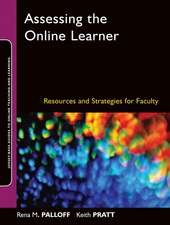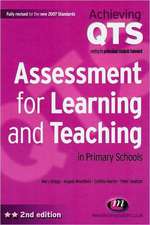Taking Ownership of Accreditation: Assessment Processes that Promote Institutional Improvement and Faculty Engagement
Editat de Amy Driscoll, Diane Cordero De Noriegaen Limba Engleză Paperback – 12 apr 2006
Preț: 248.44 lei
Nou
Puncte Express: 373
Preț estimativ în valută:
47.54€ • 49.57$ • 39.51£
47.54€ • 49.57$ • 39.51£
Carte tipărită la comandă
Livrare economică 20 martie-03 aprilie
Preluare comenzi: 021 569.72.76
Specificații
ISBN-13: 9781579221768
ISBN-10: 1579221769
Pagini: 272
Dimensiuni: 152 x 229 x 15 mm
Greutate: 0.39 kg
Ediția:1
Editura: Taylor & Francis
Colecția Routledge
Locul publicării:Oxford, United Kingdom
ISBN-10: 1579221769
Pagini: 272
Dimensiuni: 152 x 229 x 15 mm
Greutate: 0.39 kg
Ediția:1
Editura: Taylor & Francis
Colecția Routledge
Locul publicării:Oxford, United Kingdom
Public țintă
Postgraduate and Professional Practice & DevelopmentCuprins
CONTENTS Preface. Judith Ramaley 1 - Assessment and Accreditation. Potential for Productive Partnership - Amy Driscoll Introduction Setting the Stage Assessment of the Past Resistance to Assessment Ongoing Resistance Indications of Change From Resistance to Responsibility Remaining Challenges Gaining Momentum. From Triggers to Engagement The Implications of New Roles Assessment Today Guidance for the Times Looking to the Future of Assessment Accreditation of the Past Seeds of the Paradigm Shift Progress in Accreditation Shifts Continued Pressures Prompt Paradigm Shifts Assessment and Accreditation On Parallel Tracks Ongoing Challenges to a Complete Shift Evidence of The Accreditation Shift Learning from Accreditation Assessment and Accreditation. Partners for Improvement Previews. Integrating Assessment and Accreditation The Future of Accreditation and Assessment 2 - California State University and Western Association of Schools and Colleges - Amy Driscoll Introduction Descriptions from Two Perspectives An Important Caveat Western Association of Schools and Colleges. Innovative Accreditation Thinking Design Principles to Guide Development Processes Preliminary Steps for an Initial Accreditation Preliminaries. Proposal for Self-Study. Submitted, Review, and Approved Stage One. Preparatory Review -- Assessing Institutional Capacity Stage Two. Educational Effectiveness Review -- Assessing Inquiry and Engagement Summary of WASC Accreditation Processes and Philosophy California State University Monterey Bay. Innovative Accreditation Thinking Approaching the Preparatory Review. Capturing the Institution’s Unique Commitment Approaching Educational Effectiveness. Capturing Uniqueness of Approaches The Scholarship of Assessment. Enhancing Accreditation Summary 3 - Institutional Vision, Values, and Mission. Foundational Filters for Inquiry - Diane Cordero de Noriega A Trio of Guides for Campus Practices and Assessment Vision. The Soul that Guides the Institution Core Values. The Heart of the Institution Mission. The Mind of the Institution A Trifocal Lens. Filtering Our Intentions and Inquiry Academic Programs Recruitment and Training Strategic Planning Budgeting and Resource Decisions Bringing It All Into Focus Accountability—Opportunities for Change Environmental Scans—Internal and External Conclusion 4 - Preparing for Accreditation. Sowing the Seeds of Long-term Change - Salina Diiorio Introduction Directions for Preparation Preparing the Soil. Communicating and Working with Campus Constituents CSUMB’s Strategies for Working and Communicating with Groups Communicating through a Variety of Venues How These Communication Strategies Led to Long-term Change Advice for Other Campuses. Communicating Effectively and Promoting Change Weeding and Pruning. Selecting the Best Evidence to Grow CSUMB’s Strategies for Selecting Evidence Three Levels of Evidence How Our Evidence Selection Processes Led to Long-term Change Advice for Other Campuses. Selecting Your Evidence Harvesting and Arranging. Presenting the Evidence CSUMB’s Strategies for Evidence Presentation Evidence Maps Document Room Archives How Our Presentation Strategies Led to Long-term Change Advice for Other Campuses. Presenting Evidence Effectively Moving On To Other Pastures? 5 - Program Review as a Model of Vision-based Continuous Renewal - Seth Pollack Introduction Overview. CSUMB’s Academic Program Review Process Academic Program Review. Formal Process and Timeline Revision of the Initial Committee Mandate Additional Processes. Facilitating Campus-Wide Discussion Reflections on This Process through a “Best Practices” Lens Reflection on CSUMB’s Process Conclusion. Enhancing Educational Effectiveness Through Academic Degree Program Review 6 - Multi-Layered Inquiry for Program Review. Methods and Analysis for Campus-wide Implications - Annette March Introduction Rationale for Inquiry Resources for Inquiry Decisions for Inquiry Implementing a Multi-Layered Inquiry. Planning and Design Collecting Preliminary Research Data to Inform Assessment Design Constructing an Inquiry Focused on Institutional Goals and Outcomes Designing the Inquiry to Systematically Examine Multiple Forms of Data from Multiple Stakeholders Using Varied Empirical Data Methods to Provide Triangulation Using Ethnographic Techniques to Contextualize the Assessment Data Implementing a Multi-Layered Inquiry. Collecting the Data Using Interviews to Probe Deeply Using Ethnographic Methodology to Probe Deeply for Program Effectiveness Using Direct and Quantitative Methods to Triangulate Indirect Qualitative Methods. Practicing a Recursive Collection Process Implementing a Multi-Layered Inquiry. Analyzing Data Applying Simple and Direct Techniques Applying Triangulation to Cross-check Reliability of Emerging Findings Returning to the Literature During the Research Stage to Pursue New Lines of Inquiry Implementing a Multi-Layered Inquiry. Writing the Report Recording the Comprehensive Assessment in a Comprehensive Report Recording the Results in a Consistent and Clear Manner Emphasizing Alignment of the Data, Results, and Recommendations Linking Recommendations to Each Decision-Making Stakeholder Tailoring a Report Format that Fits the Assessments’ Intentions and Audiences Implementing a Multi-Layered Inquiry. Dissemination Disseminating Widely and Strategically Across Campus Tailoring Various Venues for Opportunities to Interact about the Information Implementing a Multi-Layered Inquiry. Closing the Loop Aiming for Appropriate Changes from Assessment Results Considering Assessment a Transformative Cycle Adapting the Writing Program Inquiry Process for Your Campus Conduct the Assessment Collaboratively Streamline the Process for Individual Programmatic Needs 7 - Examining Capstone Practices. A Model of Assets-Based Self-Study - Dan Shapiro Introduction The Self-Study Model Asset vs. Deficit Model of Self-Study Implementing the Self-Study Step 1. Identify student leaning and assessment programs or processes on campus common to multiple departments Step 2. Of these programs or processes, select one that should be given high priority for a campus self-study Step 3. Identify and prioritize goals for the self-study of this program or process Step 4. Determine the audience(s. and methods and for the self-study Step 5. Determine how the results of the self-study will be used to achieve the intended goals Brief Summary of Self-study Results Self-Study Perceptions Self-Study Concerns Self-Study Recommendations The CSUMB Capstone Self-Study and Accreditation. Emerging Institutional Improvement Direction from Accreditation Conclusion 8 - A Study of “Best Practices” in Assessment. A Visible and Public Learning Process - Betty McEady Introduction The Research Processes Research Process One. Search for Best Practices Research Process Two. Develop Survey Questions Research Process Three. Develop Faculty Response Tables Research Process Four. Administer the “Best Practices” Interviews Evidence of “Best Practices” in
Notă biografică
Amy Driscoll retired from California State University, Monterey Bay as the founding Director of Teaching, Learning, and Assessment and from Portland State University as Director of Community/University Partnerships. For the last 11 years, she has coordinated and taught in the Assessment Leadership Academy, a year-long program for faculty and administrators, and consulted nationally and internationally. She co-authored Developing Outcomes-based Assessment for Learner-centered Education: A Faculty Introduction with Swarup Wood in 2007. Diane Cordero De Noriega is Provost and Vice President for Academic Affairs, and currently Interim President, at California State University, Monterey Bay. Judith A. Ramaley is President of Winona State University. Prior to coming to Minnesota, Dr. Ramaley held a presidential professorship in biomedical sciences at the University of Maine and was a Fellow of the Margaret Chase Smith Center for Public Policy. She also completed a residency as a Visiting Senior Scientist at the National Academy of Sciences.From 2001 to 2004, Dr. Ramaley was Assistant Director, Education and Human Resources Directorate (EHR) at the National Science Foundation (NSF). Prior to joining NSF, Dr. Ramaley was president and professor of biology at the University of Vermont. Dr. Ramaley has a special interest in higher education reform and has played a significant role in designing regional alliances to promote educational cooperation. She has contributed to national discussions about the changing nature of work and the workforce. She plays a national role in the exploration of civic responsibility and the role of higher education in promoting good citizenship. She also has published extensively on educational reform; science, technology, engineering, and mathematics education; and the leadership of organizational change.
Recenzii
“Many institutions look upon accreditation with a kind of compliance mentality: ‘Just tell us what you want so we can get this over with.’ In this book CSU Monterey Bay shows us a different and better way–not in how to play the game, or in how to get through the process with a minimum of fuss, but in how to use accreditation to make the institution a better place. Those who seek a model for how to do accreditation right will find it in this book.”
Jon F. Wergin, Professor, Ph.D.
Program in Leadership and Change, Antioch University
“Taking Ownership of Accreditation outlines a way to use the accreditation process to develop a new, productive intentionality, aligning it with learning outcomes assessment and recursive qualitative and quantitative institutional research. Driscoll and Cordero demonstrate how California State University, Monterey Bay, by aiming at issues of high priority and keen interest, clarified and deepened its ability to educate students and serve its community. Of particular importance to community colleges is CSUMB’s focus on engaging external constituents as both constituents and a prime audience for the self study reports. This is a comprehensive primer for those who care about creating productive institutional change at colleges and universities.”
Gail O. Mellow, President
LaGuardia Community College
“This revealing account describes how CSUMB worked on the inside to develop an exceptional learning organization that set a new approach to accreditation. It shows how internal commitment can be joined with external accreditation requirements to engage faculty in scholarly inquiry about student and faculty learning, leading to a number of innovative activities that serve the University long after the accrediting team leaves. This book is useful whether you have an accrediting visit coming soon or not."
Ralph A. Wolff, Executive Director
Accrediting Commission for Senior Colleges and Universities, Western Association of Schools and Coll
Jon F. Wergin, Professor, Ph.D.
Program in Leadership and Change, Antioch University
“Taking Ownership of Accreditation outlines a way to use the accreditation process to develop a new, productive intentionality, aligning it with learning outcomes assessment and recursive qualitative and quantitative institutional research. Driscoll and Cordero demonstrate how California State University, Monterey Bay, by aiming at issues of high priority and keen interest, clarified and deepened its ability to educate students and serve its community. Of particular importance to community colleges is CSUMB’s focus on engaging external constituents as both constituents and a prime audience for the self study reports. This is a comprehensive primer for those who care about creating productive institutional change at colleges and universities.”
Gail O. Mellow, President
LaGuardia Community College
“This revealing account describes how CSUMB worked on the inside to develop an exceptional learning organization that set a new approach to accreditation. It shows how internal commitment can be joined with external accreditation requirements to engage faculty in scholarly inquiry about student and faculty learning, leading to a number of innovative activities that serve the University long after the accrediting team leaves. This book is useful whether you have an accrediting visit coming soon or not."
Ralph A. Wolff, Executive Director
Accrediting Commission for Senior Colleges and Universities, Western Association of Schools and Coll
Descriere
This book demonstrates how a participatory approach to assessment and accreditation in their new forms creates a synergy for learner-centered education. It is a guide to approaching the accreditation process from a campus-wide perspective of ownership--illustrated by rich descriptions.








